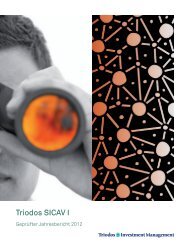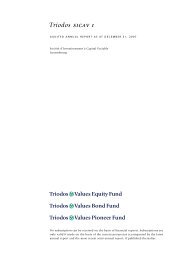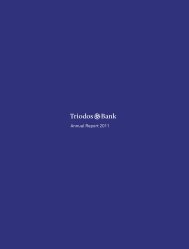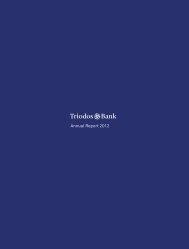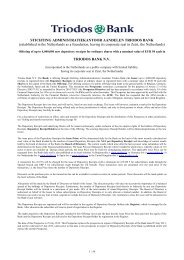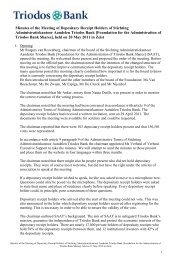TlB Annual Report 2009 - Triodos Bank
TlB Annual Report 2009 - Triodos Bank
TlB Annual Report 2009 - Triodos Bank
You also want an ePaper? Increase the reach of your titles
YUMPU automatically turns print PDFs into web optimized ePapers that Google loves.
BASIS OF NOTES AND ENVIRONMENTAL KEY<br />
FIGURES<br />
The environmental key figures show the total<br />
figure for the five branches expressed per fte.<br />
The <strong>Bank</strong>’s temporary co-workers are included<br />
in the calculation of the environmental figures.<br />
This provides a more realistic picture of the<br />
organisation’s actual environmental impact.<br />
The co-workers engaged by <strong>Triodos</strong> MeesPierson<br />
are not included in this calculation because<br />
they do not use <strong>Triodos</strong> <strong>Bank</strong>’s buildings. The<br />
co-workers engaged by <strong>Triodos</strong> Real Estate<br />
Development use <strong>Triodos</strong> <strong>Bank</strong>’s facilities and<br />
are therefore included.<br />
The energy figures show the electricity and gas<br />
consumption per fte. The figures are derived<br />
from invoices and meter readings. The head<br />
office in Zeist and the branch in Spain do not<br />
use gas.<br />
Business travel data shows the number of<br />
kilometres per fte travelled by co-workers by<br />
public transport, plane, and car - whether in a<br />
private car or taxi based on distance declarations<br />
or in a company car using mileage readings.<br />
Travel by plane and public transport is calculated<br />
on the basis of ticket data. Commuting<br />
distances are shown per fte and are based on<br />
the distance between home and work, as well as<br />
on data from interviews or co-worker questionnaires<br />
detailing the means of transport used.<br />
A car-pooler is defined as a co-worker who<br />
shares a car with another co-worker for<br />
commuting purposes.<br />
Paper usage is calculated using procurement<br />
invoices and by calculating the weight of the<br />
different types of paper used in each office.<br />
The <strong>Bank</strong> purchased a new office at the end of<br />
<strong>2009</strong>. This office has not been taken up in the<br />
figures because it is not officially in use.<br />
The m 2 of the offices in The Netherlands have<br />
been corrected because figures from an official<br />
measurement in June 2008 are taken into<br />
account this year.<br />
In <strong>2009</strong> the CO2 emissions were calculated by<br />
the Climate Neutral Group for the first time.<br />
We now follow the United Nations Environmental<br />
Programme methodology to calculate<br />
emissions rather than the Greenhouse Gas<br />
Protocol that we used in the past. The two<br />
methodologies have a lot of similarities,<br />
although the unep methodology of calculating<br />
CO2 emissions is more relevant to an office<br />
environment. The unep methodology uses a<br />
more accurate way of calculating CO2 emissions<br />
of paper, making a distinction between office<br />
use of paper and printed paper that has a<br />
higher emission rate. The difference in CO2<br />
emissions between the two calculation methods<br />
will be compensated in <strong>2009</strong>.<br />
Emission of CO2 (equivalents)<br />
in thousands of kg<br />
<strong>2009</strong>* 2008*<br />
Electricity<br />
Gas consumption<br />
138 83<br />
(heating) 130 57<br />
Paper 600 581<br />
Public Transport 80 66<br />
Car 832 634<br />
Flights 824 676<br />
Total<br />
Minus: Compensation<br />
2604 2097<br />
for CO2 credits (2604 (2097)<br />
CO2 balance (neutral)<br />
CO2 compensation costs<br />
0 0<br />
per tonne (EUR) 12.50** 12.50<br />
* These 2008 figures are calculated using the UNEP methodology of<br />
calculating CO2 emissions<br />
** According to The Gold Standard, 50% of the CO2 emissions was<br />
compensated by emission reduction projects, representing a value<br />
of EUR 15 per tonne of CO2. The other 50% is accounted for by<br />
sustainable forestry projects representing a value of EUR 10 per<br />
tonne of CO2.<br />
TRIODOS BANK - ANNUAL REPORT <strong>2009</strong> 79



